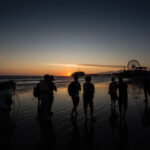The exposure triangle — formed by aperture, shutter speed, and ISO — is a key component of photography. However, while your aperture and shutter speed affect exposure physically, ISO works a little differently. In this video tutorial, David Bergman explains the top characteristics and differences between base and native ISO.
How Does ISO Work?
Your shutter speed and aperture block or limit how much light gets to your sensor. However, ISO adjustment happens just before analog data from your sensor is converted into digital. This results in superior exposure adjustment compared to simply editing an image in a program later on.
What Do ISO Numbers Mean?
ISO numbers actually originate from the film photography days and never changed when cameras went digital.
“ISO numbers are kind of a holdover from the film days. And I’m pretty sure they didn’t change them because film photographers at the time — like me — would have had a much harder time transitioning to digital if those numbers all became something different….”
ISO settings work straightforwardly enough. Essentially, every time you double your ISO, you’re adding one stop. So, upping it from 100 to 200 is 1 stop, upping it from 200 to 400 is one more — then 400 to 800 another, and so on.
Why Do High ISO Settings Create Noise?
Noise is a typical side-effect of increasing your ISO — especially when shooting with less light. Graininess occurs because the increase in ISO ups the voltage to your camera’s sensor, raising its signal and digital noise.
In low-light situations, the camera has to “fill in” very dark patches using minimal info, resulting in those blurry, noisy, or grainy patches. That said, newer cameras generally have superior processors, which are better at reducing noise and graininess at higher ISO settings.
What Is Native ISO?
Native ISO is the range of ISO settings that cameras can produce without any extra digital manipulation. Anything above or below, like Hi or Low ISO, are generally extended ISO settings. Extended ISO’s tend to offer worse quality images with less dynamic range, similar to edits done in Adobe Lightroom or Photoshop.
What Is Base ISO?
Base ISO is the lowest ISO in the native ISO range. Usually, it’s around 80 or 100 ISO, but this figure can be as high as 200, too. Typically, your camera’s base ISO is around 0 decibels of amplification — meaning you get the lowest possible noise at this setting.
What Is Dual-Base ISO?
Cameras with dual-base ISO feature multiple base ISOs instead of one, as two different circuits are connected to these camera’s processors. A low-gain circuit for situations where there’s ample light.
And a high-gain circuit, which can apply more current to the sensor in low-light conditions. Dual-base ISO is more commonly found with video cameras than still cameras. Great, as they allow you to shoot at high ISO while still causing as little noise as possible.
To Conclude:
ISO mainly affects exposure, but the number one reason why photographers are scared to adjust it is due to noise. In bright conditions, graininess shouldn’t be an issue — but low light poses a bigger risk.
David’s advice? Go for your base ISO or the closest to it, and don’t worry too much about a little bit of noise. You can employ many effective techniques to edit out or reduce noise from images.
Like This Article?
Don't Miss The Next One!
Join over 100,000 photographers of all experience levels who receive our free photography tips and articles to stay current:






